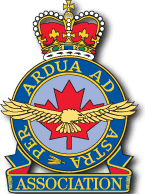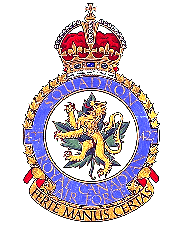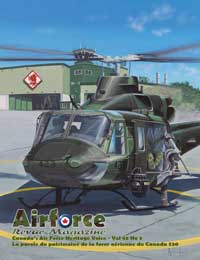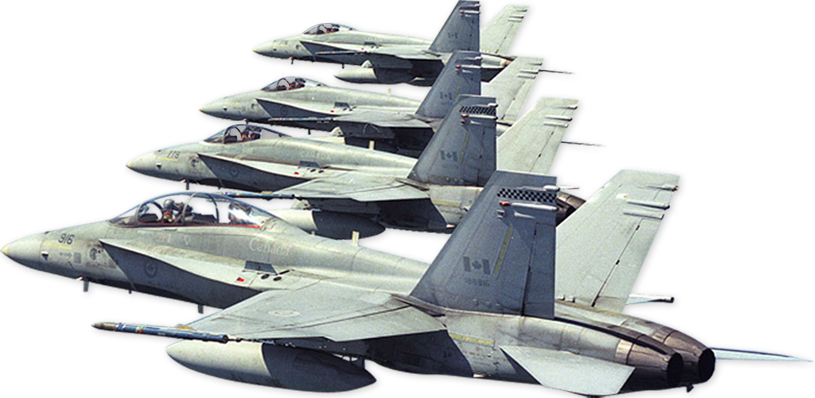 No. 427 Squadron
No. 427 Squadron
Badge: In front of a maple leaf a lion rampant
Motto: Ferte manus certas (Strike with a sure hand)
Authority: King George VI, October 1943
The combination of a lion representing England and a maple leaf for Canada indicates the formation of this squadron in England.
Formed at Croft, Yorkshire, England on 7 November 1942 as the RCAF’s 25th – eighth Bomber – squadron formed overseas, the unit flew Wellington, Halifax and Lancaster aircraft on strategic and tactical bombing operations. After hostilities in Europe, it remained in England as part of Bomber Command’s strike force, under which it airlifted Allied prisoners of war, and British troops from Italy, back to England. The squadron was disbanded at Leeming, Yorkshire on 1 June 1946.
Brief Chronology: Formed at Croft, Yorks., Eng. 7 Nov 42. Disbanded at Leeming, Yorks. 1 Jun 46.
Title or Nickname: “Lion”
Adoption: Metro-Goldwyn-Mayer Studios, Hollywood, USA, May 1943 (MGM also symbolized by lion).
Commanders
- W/C D.H. Burnside (RAF), DFC and Bar 7 Nov 42 – 5 Sep 43 OTE.
- W/C R.S. Turnbull, DFC, AFC, DFM 6 Sep 43 – 13 Jun 44 2OTE.
- W/C C.J. Cribb (RAF), DFC 14 Jun 44 – 27 Aug 44 OTE.
- W/C E.M. Bryson 28 Aug 44 – 26 Sep 44 OTE.
- W/C V.F. Ganderton, DSO, DFC 27 Sep 44 – 8 May 45 2OTE.
- W/C E.M. Bryson, DFC 9 May 45 -11 Jun 45. R.D.P. Blagrave 12 Jun 45 – 2 Oct 45.
- W/C R.D.P. Blagrave 12 Jun 45 – 2 Oct 45
- W/C J.C.R. Brown, DFC and Bar 3 Oct 45 – 1 Jun 46.
Higher Formations and Squadron Locations Bomber Command:
No. 4 Group,
- Croft, Yorks. 7 Nov 42 – 31 Dec 42.
No. 6 (RCAF) Group,
- Croft, Yorks. 1 Jan 43 – 4 May 43.
No. 63 (RCAF) Base,
- Leeming, Yorks. S May 43 – 29 Aug 45.
No. 1 Group,
- Leeming, Yorks. 30 Aug 45 – 1 Jun 46.
Representative Aircraft (Unit Code ZL)
Vickers Wellington B.Mk.III (Nov 42 – Mar 43)
- 21604 P BK364 K BK389 L
Vickers Wellington B.Mk.X (Feb – May 43)
Handley Page Halifax B.Mk.V (May 43 – Feb 44)
- EB241 A EB243 U EB246 S EB247 P DK146 Q DK186 L DK226 Y LK627 K LK633 G LK637 V LK643 T
LK644 C LK658 H LK684 R LK799 N LK923 B LK965 W LK972 F LK974 J LK975 E LK976 Z LL139 D LL169 L LU 94 C
Handley Page Halifax B.Mk.III (Jan 44 – Mar 45)
- MZ304 B LK755 S L V828 Q L V829 D L V830 H LV831 P LV883 W LV922 B LV986 V LV987 K LV994 J LV995 Y LV996 E LW161 V LW162 D LW163 U LW548 L LWSS8 A LW559 F LW572 R LW575 0 LW576 C LW577 K LW759 Z
Avro Lancaster B.Mk.l & III (Mar 45 – May 46)
- ME393 D ME426 C ME498 K MESOl T NX548 J NX549 U NXSSO V NXSSl G NX552 S NX553 H NX554 F NXSSS R PA260 Q PA263 E PA271 W RAS34 A RA536 N RA537 P RA538 B RA539 0
Operational History: First Mission 14 December 1942, 3 Wellington Ill’s from Croft despatched to lay mines in the Frisian Islands area; 2 aborted owing to weather.
First Mission: Bombing 15/16 January 1943, 6 Wellington Ill’s from Croft despatched to bomb Lorient, France; S bombed the primary target, 1 failed to return.
Last Mission: 25 April 1945, 10 Lancasters from Leeming despatched to bomb gun positions on the Island of Wangerooge; 9 bombed the primary target, 1 bombed buildings on the Island of Spiekeroog.
Summary Sorties: 3328.
- Operational/Non-operational Flying Hours: 18,512/11,271.
- Bombs dropped: 10,294 tons.
- Victories: Aircraft: 10 destroyed, 1 probably destroyed, 10 damaged.
- Casualties:
- Operational: 90 aircraft; 522 aircrew, of whom 35 were killed, 477 missing (of whom 10 POW, 11 proved safe), 10 injured.
- Non-operational: 6 aircraft; 22 personnel, of whom 15 were killed, 5 injured, 2 died of natural causes.
For a list of the names of those killed on operations, please visit this webpage, here.
Honours and Awards: 4 DSO’s, 6 bars to DFC, 147 DFC’s, 1 AFC, 2 CGM’s, 16 DFM’s, 8 MiD’s.
Battle Honours
English Channel and North Sea 1943-1945.
Baltic 1944-1945.
Fortress Europe 1943-1944.
France and Germany 1944-1945:
Biscay Ports 1943-1944,
Ruhr 1943-1945,
Berlin 1943-1944,
German Ports 1943-1945,
Normandy 1944,
Rhine. Biscay 1944.
Ferte Manus Certas 427 Squadron, Cenotaph Project
OCdt Michaela Dagg
First formed in Croft, County Durham on 7 November 1942, 427 Squadron has evolved to become the squadron it is today. Having flown eight different aircraft since its birth, 427 Squadron has seen numerous conflicts, and been disbanded and re-established more than once.
427 Squadron will celebrate its 75th anniversary in 2017, and with this celebration come plans to build a cenotaph in Memorial Park on Canadian Forces Garrison Petawawa, Ontario, where the Squadron is now located. The cenotaph will be comprised of two crossed walls, atop which will sit a 7’ by 8” polished granite base on which a bronze lion, the Squadron’s mascot will proudly stand. On the walls, the eight aircraft historically flown by the Squadron will be etched, along with the names of the 222 members that the Squadron has lost in combat and training. Of these members, 214 were lost in the Second World War; two during the Cold War, and six more after the Squadron was converted to a tactical helicopter squadron.
Throughout its life the Squadron has received various Battle Honours, as listed below:
- English Channel and North Sea 1943–1945
- Baltic 1944–1945
- Fortress Europe 1943–1944
- France and Germany 1944–1945
- Biscay 1944
- Biscay Ports 1943–1944
- Ruhr 1943–1945
- Berlin 1943–1944
- German Ports 1943–1945
- Normandy 1944
- Rhine
- Afghanistan [6]
Beginning in 1942, 427 Squadron operated first with the RAF for a short time before being moved to 6 Group RCAF. The Squadron initially flew several versions of the Wellington bomber in the Bomber Command up until 1943, when they moved to Leeming in North Yorkshire and were then equipped with the four-engined Halifax bomber. The Squadron changed aircraft once more before the end of the Second World War, to the Avro Lancaster Bomber on 11 March 1945. The Squadron wrapped up their operations in the war in the Lancaster, their last mission being the bombing of gun positions on Wangerooge Island, off the coasts of Germany. After the conclusion of the Second World War, 427 Squadron continued with the Lancasters, and aided in returning POWs from camps in Europe. The Squadron was disbanded for the first time on 31 May 1946.
1943 also saw the Squadron being adopted by Metro-Goldwyn-Mayer, and presented a bronze Lion statue and permitted the names of actresses signed to their label to be scrawled on the 427 aircraft. Mareth, the lion cub, was also adopted by the Squadron he was one of British Prime Minister Winston Churchill’s cubs. The cub was housed at a zoo in London, England until his death.
Six years following the first disbanding of the Squadron, on 1 August 1952, the Squadron was reactivated and reset as a fighter squadron in the Air Defence Command, based in St Hubert, Quebec and equipped with F-86 Sabre MK IIs. The Squadron moved on to two different versions of the Sabre while working out of St Hubert before deploying to Zweibrücken, Germany and becoming a part of 3 Wing, in March-April 1953. The Squadron continued in this role, operating out of Germany, for another decade, participating in many multi-national NATO exchanges and exercises with destinations including; Rabat, Morocco, Decimomannu, Sardinia and France.
1962 saw the Squadron disbanded again, but only for two days. On 15 December 1962, the Squadron was deactivated as a Fighter squadron and reactivated on the 17th as a Strike/Attack squadron. With this change, 427 Squadron also became the first of the Canadian squadrons to be equipped with the CF-104 Starfighter. This change in aircraft called for a change in training and tactics as well, introducing high speed low level radar navigation into the Squadron’s arsenal of skills. 1969 brought another change for the Squadron, this time, a move from Zweibrücken to Baden-Soellingen, and with that, a change from 3 Wing to 4 Wing.
The Squadron performed well at everything that came its way during this time, winning multiple trophies, as listed below:
Air Division Trophy, 1965;
Bradshaw Trophy, 1966; and
Top Gun, 1967, 1970.
They also recovered a downed Halifax bomber in Holland that had been flown by 427 Squadron in the early days, pieces of which are held as mementos by the Squadron.
The Squadron disbanded for the last time to date on 1 July 1970 and was re-established on 1 January 1971 as a Tactical Helicopter Squadron with 10 Tactical Air Group of Mobile Command, later simply called ‘Air Command.’ The first helicopter used after this transition was the CH-136 Kiowa light observer helicopter and, simultaneously, the CH-135 Twin Huey utility helicopters. The Squadron has participated in many operations since switching to tactical helicopters, including:
Norway
Egypt
Sinai Peninsula (Op CALUMET)
Central America (Op SULTAN)
After switching to a fleet of only CH-135 Twin Huey’s in 1992, the Squadron deployed on more operations, to Somalia in 1993 in support of Operation DELIVERANCE and to Haiti in 1995 up to the present on Operations PIVOT and STABLE.
In July 1997 the Squadron received the BELL CH-146 Griffon Helicopter fleet to replace the Twin Huey. By 1999, the Griffon’s had racked up experience in three different operations, the domestic Operation RECUPERATION in 1998 and Operation HURRICANE in 1999 and overseas in Operation CENTRAL in Honduras in 1998. The early 2000’s saw rotations going to Bosnia, where rotations from 427 Squadron proved to be integral to mission successes.
On 1 February 2006, 427 Squadron became part of Canadian Special Operations Forces Command (CANSOFCOM), with the responsibility of providing air capability to various units with the Canadian Special Forces Command, where it remains today.
July 8 2016 at 427 Special Operations Aviation Squadron in Petawawa, Ontario, a long awaited fund raising campaign has kicked off, beginning with the donation of $1,000. by HCol D. Lippert to the Commanding Officer of 427 SOAS, LCol C. Rook The fund raising campaign, has been launched to raise the funds necessary to construct the cenotaph in Memorial Park on CFB Petawawa, commemorating the 222 lives lost in service of Canada. We do not have a Cenotaph honoring these hero’s in Canada.
The funds needed for this project are estimated at $125 000.00 for the total construction and need to be raised entirely by Private funding, Zone G-7 The Royal Canadian Legion are supporting this project along with the RCAF Association and 427 Association.
How to donate
By Mail:
Make Cheques out to: “RCAF Association Trust Fund” and write in the “Memo Portion” 427 Association Cenotaph Fund
Mail to: Office Manager RCAF Association Trust Fund, 222 Somerset Street West, Suite 405. Ottawa, ON, K2P 2G3.
Or
Online:
Go to: www.canadahelps.org.
Search by Charity Keywords: Royal Canadian Air Force Association Trust Fund.
Select: Royal Canadian Air Force Association Trust in Ottawa, ON
Scroll Down to: ‘Donate to this Charity Now’
Select from the dropdown menu: 427 Lion Squadron Association Memorial Cenotaph Cause.
Tax receipts will be sent by: The Royal Canadian Air Force Association by mail if you mail in your cheque, or by e-mail if you donate through Canadahelps.org









